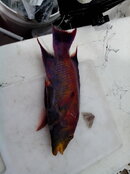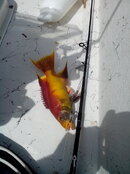the dots on the back.. even though my first thought looking at the photo is that it is a grasby. I think that a different angle you would see the dots. The first one, looks really faded.I can never come close to keeping up with you on the reef fish IDs, but I usually do a little better on the dinner fish. While this fish generally looks like a graysby, I would not have been positive about that because I don't see the 3 black dots on it's back. Do those dots appear as the fish gets bigger? Are they there, but I am just not noticing them? Does that species sometimes not have them? Do I ask too many silly questions?
Edit:
When I went to google up additional pictures, I came across this - Man sets state record with Graysby Grouper catch I can't see the dots on that one either, but maybe it's just the angle. Reading that this guy set a NC state record with a 2 pound 3 oz fish got me looking up the FL record. It's just over 3 pounds. I think that I may have caught some larger than that & just not known that they were trophy worthy. I guess that they run a little bigger down here.
Below are a few of the typical ones I would bring in. The one on the left shows the 3 dots, just barely because of the angle. The other two have a can of soda for a size reference, but you can't see the dots because of the angle.
This shows the 3 dots clearly - Ein grauer Fisch hält in der Schüssel eines großen Fassschwamms auf...
You are using an out of date browser. It may not display this or other websites correctly.
You should upgrade or use an alternative browser.
You should upgrade or use an alternative browser.
Blue Heron Bridge Trolls III
- Thread starter BHB ScubaTroll
- Start date
Please register or login
Welcome to ScubaBoard, the world's largest scuba diving community. Registration is not required to read the forums, but we encourage you to join. Joining has its benefits and enables you to participate in the discussions.
Benefits of registering include
- Ability to post and comment on topics and discussions.
- A Free photo gallery to share your dive photos with the world.
- You can make this box go away
Now that I think about it some more, perhaps the black dots on that Graysby just blend in at depth because the reds are not so red down there & that removes the color contrast that would normally make the black dots easily visible when viewing the fish at the surface.
A lot of fish look different at depth compared to the way they look at the surface. Hogfish are a good example, especially the more colorful varieties like the Spanish hogs, or the spot fins.
A lot of fish look different at depth compared to the way they look at the surface. Hogfish are a good example, especially the more colorful varieties like the Spanish hogs, or the spot fins.
Attachments
Went to the bridge for diving today. Arrived at 0733 for an 0857 high tide. The park was pleasantly not crowded, I would expected a few more people for a high tide at 0857. I suspect that a lot of people will take off Friday, to make a four day weekend out of it, and it will thusly be more crowded tomorrow. Entered on the westside through the wide open construction gate at 0805. The visibility was as good as I have seen it in at least month, in the 50ft range. However, along with clear blue water there was a drop in temperature as well. Sea temp of 79F! It was 86F on Tuesday, and 83F yesterday. The last time it was in the high 70's it was also very green. I have no good oceanographic explanation of cold blue water, regardless I will be happy to dive in it as long as it lasts. The current was unusually strong today as well. And did not subside until well after 0857 that I got off the tide chart. Did a REEF fish survey of 63 species in 65 minutes. Observed a Spotted Eagle Ray, I had not seen one for a while. Observed a Southern Sting Ray demolish a box crab. I did not admonish her for making a mess out of the visibility. I did not encounter a single other diver for the entire time I was underwater, SWEET! Respectively, Hogfish, Juvenile Queen Angelfish, Rainbow Parrotfish, Silver Jenny, and Southern Stingray





So I went to Inaturalist.org and queried Graysby. There were 700+ observations of Graysby. I looked at a few hundred. Most of them had the black dots, on some of them the dots are difficult to distinguish, and some them have white dots like this specimen I took a photo of at BHB in 2018.While this fish generally looks like a graysby, I would not have been positive about that because I don't see the 3 black dots on it's back. Do those dots appear as the fish gets bigger? Are they there, but I am just not noticing them? Does that species sometimes not have them?
I hope the vis holds!
Heard (besides Pipehorse) that viz was excellent but cold!
Green Frog
Contributor
Great images, Pipehorse! The pictures I've seen lately of Queen Angelfish both in FL and out in the Bahamas have all showed a lot of yellow in the main body coloration. When I first started diving in the Bahamas over 30 years ago, it seems like I remember them normally being more blue with yellow only in limited amounts. Is this just my faulty memory, or has their actually been a "drift" in their average coloration?

I had texted @Scuba_Jenny the day prior and said, "Watch vis be 50 ft tomorrow." Drop theThe visibility was as good as I have seen it in at least month, in the 50ft range.
Went to the bridge for diving today. Arrived at 0731 for an 0952 high tide. The park was not crowded. Hurray! What was left of the fence blocking the beach has now been removed. Total access to areas under the bridge restored. Snorkeled the trail before diving, did a REEF fish count of 45 species in 54 minutes. Entered on the west side and stayed on the west side for the entirety of the dive. The current was ripping again today. Visibility was 50ft, and sea temp was 79f. I used my three mil and was still cold at the end of the dive. Must spent 30 minutes just swimming among the Spadefish and Brassy Chubs. As some of you might now, if you hold your fin 90 degrees to the sand, the Atlantic Spadefish will approach the fin, rotate their body 90 degrees and rub themselves against the fin. I am not sure why they do it, maybe to get rid of parasites we cant see. Today I held my hand out perpendicular to the sand and the Spadefish rubbed themselves on my hand. Naturally I was not shooting video when this happened. So I set up again this time with video rolling, but could not entice them to repeat the behavior with my bare hand. Maybe next time, probably will head south to LBTS this weekend to avoid the cray-cray that goes on at the bridge during the weekends. Respectively, Barbfish Closeup, Black Grouper, Deer Cowry, Giant Hermit Crab, Juvenile Harlequin Bass, and Spadefish Video.





@Green Frog, as far as I can tell there has been no shift in the coloration of Queen Angelfish. Perhaps you are remembering Blue Angelfish, which are similar to Queen Angelfish, but have a lot less yellow?
@Green Frog, as far as I can tell there has been no shift in the coloration of Queen Angelfish. Perhaps you are remembering Blue Angelfish, which are similar to Queen Angelfish, but have a lot less yellow?
Green Frog
Contributor
You're probably right, Pipehorse. After all, I'm old enough that my memory aint what it used to be! I went back into the Paul Humann books after I posted and his pictures showed a little more blue, but nothing like I was "remembering". Regardless, those are some good pix.
Probably the best Florida dive I ever did was the drift dive off the Bath and Tennis Club @ West Palm... I got pictures of Queen, Blue, Grey, and French Angelfish as well as Rock Beauties all on that one dive. Of course that happened when Clinton was President and my diving skills and memory were both better! The last trip I had to Nassau I saw plenty of Grey and French Angels, I only saw one or two Queens and maybe one Blue. If I saw a Rock Beauty, it was at a distance.

PS On the subject of Yellow Queen Angels, years ago in the Baltimore Aquarium there was a nearly all yellow adult Queen with just the "crown" on her head to let you know "who" she was. My young niece was so smitten with her appearance that she had her tattooed on her hip. My apologies for the thread drift, but the pictures inspired old memories.
Probably the best Florida dive I ever did was the drift dive off the Bath and Tennis Club @ West Palm... I got pictures of Queen, Blue, Grey, and French Angelfish as well as Rock Beauties all on that one dive. Of course that happened when Clinton was President and my diving skills and memory were both better! The last trip I had to Nassau I saw plenty of Grey and French Angels, I only saw one or two Queens and maybe one Blue. If I saw a Rock Beauty, it was at a distance.
PS On the subject of Yellow Queen Angels, years ago in the Baltimore Aquarium there was a nearly all yellow adult Queen with just the "crown" on her head to let you know "who" she was. My young niece was so smitten with her appearance that she had her tattooed on her hip. My apologies for the thread drift, but the pictures inspired old memories.
I'm coming for the cray cray tomorrow.
Similar threads
- Replies
- 2
- Views
- 412
- Replies
- 12
- Views
- 1,813
- Replies
- 2
- Views
- 835
- Replies
- 3
- Views
- 1,108






